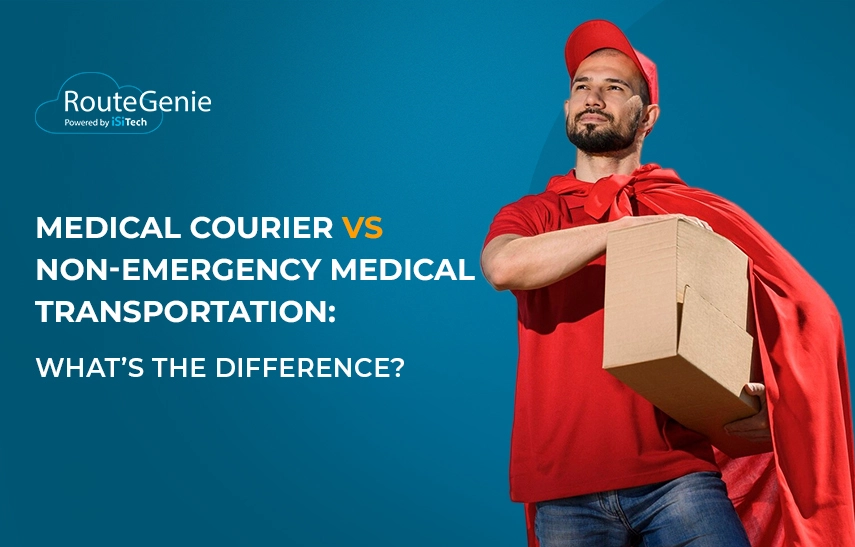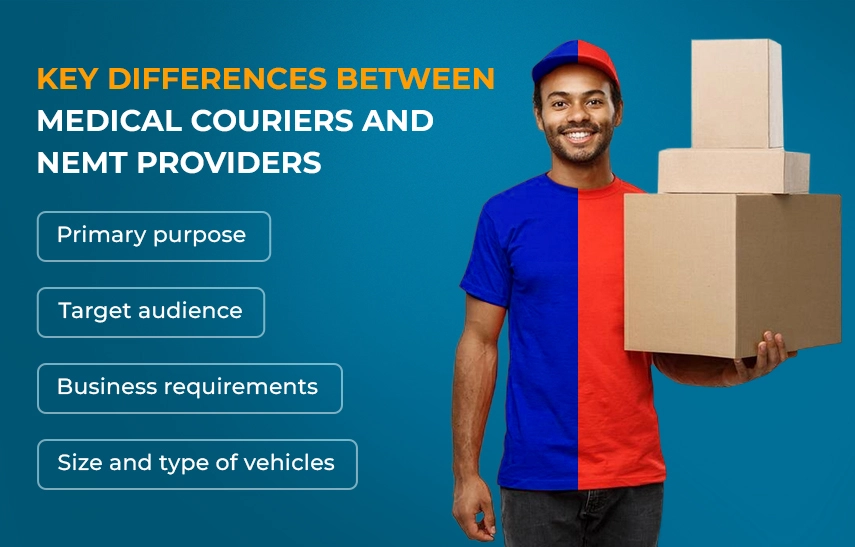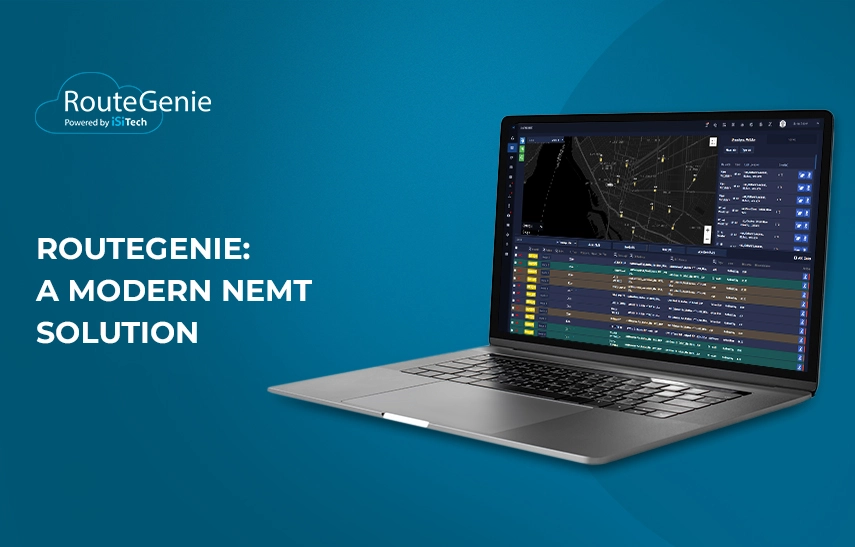Medical Courier vs Non-Emergency Medical Transportation: What’s the Difference?

Medical couriers and non-emergency medical transportation (NEMT) providers are critical to the healthcare industry.
What’s the difference between a medical courier vs NEMT?
Contents:
- What is a Medical Courier?
- What is NEMT?
- Key differences between medical couriers and NEMT providers
- Benefits and challenges of medical courier vs. NEMT
- RouteGenie: a modern NEMT solution
- FAQs
What is a Medical Courier?
Emergency medical couriers deliver critical life-saving materials and items essential for research and experiments.
These include:
- Medications
- Lab specimens
- Test results
- Medical supplies
- Healthcare-related documents
Medical couriers may also deliver other records and materials across the country daily. A lot of couriers work as independent contractors. This means they can freely manage their own schedule and keep it flexible.
Couriers need to ensure that their deliveries are always on time. Additionally, the safety of the materials and the confidentiality of the information are vital. They often work with pharmacies, laboratories, medical facilities, doctors’ offices, and other organizations.
How to become a medical courier
You do not need a specific educational background to become a courier, even if medical items are involved. However, many companies do admit that they prefer candidates who have experience working in the healthcare industry and require employees to obtain HIPAA and Bloodborne Pathogen certifications. The relevant experience would include prior employment as (or with) a pharmacist, medical assistant, nurse, or other medical professional.
Some of the requirements to become a medical courier are:
- Must be 21 or older to drive
- Extensive knowledge of the city of one’s work
- SUV or van less than ten years old
- Registered, licensed, and inspected vehicle
- Current driver’s license
- Clean driving record
- Basic tech skills for using a phone, navigation apps, and the like
What is NEMT?
Non-emergency medical transportation (NEMT) is neither an ambulance nor a taxi. This transportation service was designed for individuals who need transport to their appointments, basically, those who are not experiencing an emergency but still cannot make it to the medical appointment on their own. NEMT carriers typically use specialized vehicles to transport customers to facilities that provide healthcare services if the said customers do not possess a personal vehicle, have special mobility needs, and/or require medical assistance in transit, etc. NEMT vehicles can carry wheelchairs, stretchers, oxygen tanks, or other medical equipment.
Passengers can book NEMT services directly or through brokers using software that locates available drivers and maps the best possible routes. These specialized tools match providers with passengers depending on what vehicle they need and where to go.
Medicaid covers non-emergency medical transportation benefits in 15 states. Hospitals, clinics, and state and local institutions may also fund NEMT transportation.
How to become an NEMT provider
The requirements to become a provider vary according to the state. The first step is knowing the licensing requirements for specialized drivers and vehicles. Then, one can apply to be an NEMT provider.
Companies must complete the Medical Transportation Provider Application Package, which includes:
- Driver's license
- Vehicle registration
- Vehicle insurance
- Other required documents
Some states partner with third-party NEMT brokers to manage preauthorized services in a specific area. In this case, brokers submit bids to assume responsibility for transport on behalf of the state.
Key differences between medical couriers and NEMT providers
 Both medical couriers and NEMT providers involve transportation in healthcare, but there are some key differences between the two:
Both medical couriers and NEMT providers involve transportation in healthcare, but there are some key differences between the two:
- Primary purpose: Courier services are quite simple—they just transport medical supplies. In contrast, NEMT providers have fleets and drivers that transport passengers to healthcare facilities for non-emergency medical care.
- Target audience: Courier service providers can assist almost anyone who needs to ship medical supplies. Meanwhile, NEMT services are for passengers who meet eligibility criteria set by funding sources like Medicaid or private insurance.
- Business requirements: Medical couriers do not have the strict licensing requirements that NEMT fleets do, as they do not transport people. However, some courier types must adhere to vehicle registration and insurance requirements set by state and local governments.
- Size and type of vehicles: For small supply deliveries, a medical courier may use a standard SUV. Medical transportation fleets have much stricter requirements for their vehicles and traditionally have larger vehicles to accommodate specialized equipment for passengers. Here is a list of these requirements and some tips on how to buy a perfect NEMT vehicle.
Benefits and challenges of medical courier vs. NEMT
Medical couriers and NEMT providers are both important to the healthcare industry, but they have very different advantages and disadvantages for those who book their services.
Advantages of medical courier services:
- Quick Delivery: Delivery speed is one of the primary advantages of booking a courier service. For time-sensitive materials such as lab specimens or medications, this is a critical consideration.
- Cost-effective: Healthcare facilities can reduce expenses by working with a professional courier service.
- Expertise in Handling Medical Materials: Medical couriers possess the necessary skills to handle and transport potentially hazardous materials.
Disadvantages of medical courier services:
- Delivery Delays: Drivers can face delays due to traffic or unforeseen circumstances in the middle of a delivery. This is detrimental to those in need of time-sensitive and life-saving parcels.
- Complex Record-Keeping: Couriers must keep meticulous records of the items they handle, where they are from, and where they will be delivered. This is a delicate process, as even the slightest error in transport or record-keeping can have serious consequences.
- Compliance Requirements: It is important to follow state and federal regulations governing the delivery services of medically related items. Submitting applications and maintaining compliance can be complex and time-consuming.
Advantages of NEMT services:
- Accessibility: NEMT services provide much-needed healthcare transport to people who are unable to drive themselves or may have mobility issues.
- Accommodates Special Needs: Those with special needs can easily travel to healthcare appointments. NEMT providers have large vehicles that can fit wheelchairs and other equipment.
- Peace of Mind: NEMT providers are very reliable, giving passengers and their families peace of mind that they will get to their health appointments promptly and safely.
Disadvantages of NEMT services:
- Limited Availability: NEMT services via Medicaid are not available in every state. People living in these places may find it difficult to get essential medical care.
- Cost: Insurance may not always cover NEMT services. Passengers with limited finances cannot afford to book this type of transport.
- Coordination: Scheduling appointments and coordinating with healthcare institutions can be difficult for passengers with many health appointments.
RouteGenie: a modern NEMT solution
 RouteGenie is a modern software solution for medical transport providers. It automates all NEMT and courier-related processes. It is built to improve scheduling, billing, routing, and dispatching.
RouteGenie is a modern software solution for medical transport providers. It automates all NEMT and courier-related processes. It is built to improve scheduling, billing, routing, and dispatching.
The software helps manage issues like:
- Traffic problems
- Vehicle breakdowns
- No shows
- Add-on trips
- On-demand trips
- Driver call-offs
- Cancellations
RouteGenie focuses on automating scheduling, routing, dispatching, and billing. The software is comprehensive and customizable, making it ideal for both medical couriers and medical transportation providers.
FAQs
What does a medical courier deliver?
Medical couriers carry organs, blood products, lab specimens, equipment, pharmaceuticals, and other time-sensitive items related to healthcare.
What is non-emergency medical transportation?
NEMT companies safely transport patients with disabilities, seniors, and low-income individuals to their non-emergency doctor appointments.
How much do medical couriers make in the US?
According to Glassdoor, the average medical courier earns $30,000 to $45,000 per year.
How to become an NEMT provider?
Requirements to become an NEMT provider for Medicaid vary for different states. The application process and documentation needed depend on each state’s regulations.
How do you become a medical courier?
To become a medical courier, you generally need a reliable vehicle, a clean driving record, and knowledge of your service area. No specific education is required, but experience in healthcare or logistics can be beneficial.
Do medical couriers get paid by parcel?
Courier services have varying fee structures based on location and the nature of the delivery. Most couriers charge per parcel, but healthcare institutions can partner with a service provider and sign a long-term contract with a customized payment plan.
Who is a certified Medical Courier?
Since many customers who order services from medical couriers require them to have HIPAA and Bloodborne Pathogen certifications, a person with those certifications would be considered a certified medical courier.
About the author
An experienced content writer, Keren Dinkin’s forte is writing well-informed medical transportation, healthcare accounting, and related articles. Her work is backed by months of intensive research and pays meticulous attention to details. In addition to being a writer, she also dons the hat of a content strategist.
The author assumes no responsibility or liability for any errors or omissions in the content of this site. The information contained in this site is provided on an "as is" basis with no guarantees of completeness, accuracy, usefulness or timeliness.